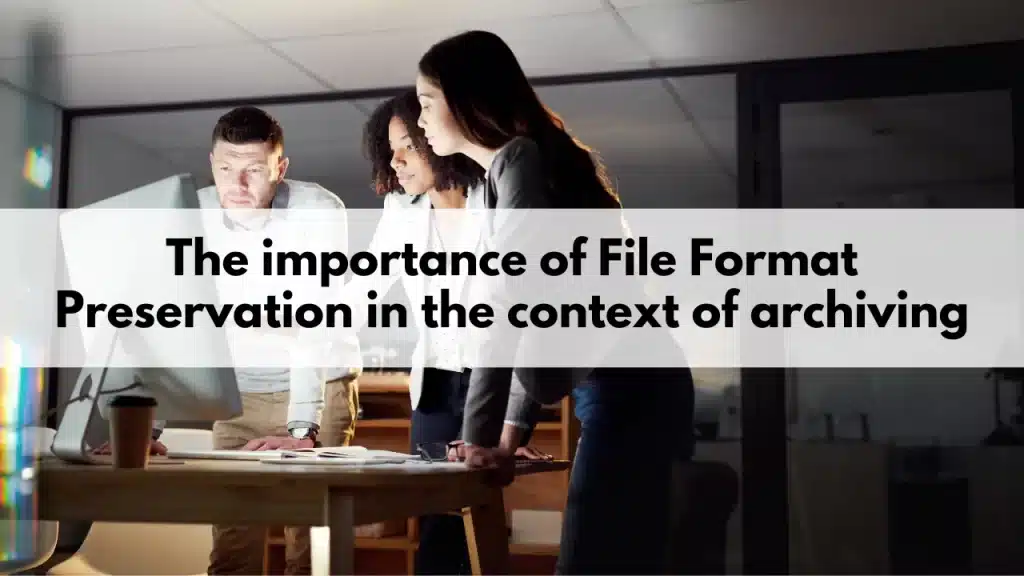File Format Preservation: What is it?
File format preservation refers to the act of maintaining the integrity and accessibility of digital files over time. It involves ensuring that electronic files can be read and understood by both current and future computer systems, even as technology evolves. The goal of file format preservation is to ensure that important digital information can be accessed and used long into the future, without the need for proprietary software or complicated conversion processes.

You will recognize this practical example.
Do you remember WordPerfect? It was not just a digital file format, but also a word processing software.
It has since become largely obsolete with the widespread adoption of Microsoft Word as the dominant word processing software. While WordPerfect is still available and in use by some individuals and organizations, it has lost much of its market share and is no longer as widely used as it once was.
Benefits of file format preservation
- Longevity of Digital Content: File format preservation ensures that digital files remain accessible and usable for a longer period of time. This helps to ensure that important digital information is not lost or becomes inaccessible as technology evolves.
- Accessibility of Historical Data: By preserving digital files, organizations and institutions can ensure that historical data remains accessible for future generations. This helps to maintain the cultural and historical heritage of societies.
- Cost Savings: By preserving digital files in a way that ensures their long-term accessibility, organizations can reduce the costs associated with having to recreate or replace lost or inaccessible data.
- Improved Data Management: File format preservation helps organizations to better manage their digital data by providing a clear and consistent way of storing, organizing and accessing their digital files.
- Reduced Risk of Data Loss: File format preservation helps to mitigate the risks associated with data loss, such as file corruption, hardware failure, or accidental deletion.
- Compatibility with Future Technology: By preserving digital files in a format that will be compatible with future technology, organizations can ensure that their data remains usable and accessible as technology advances.
- Increased Confidence in Digital Data: By preserving digital files in a way that ensures their authenticity and integrity, organizations can increase their confidence in the accuracy and reliability of their digital data.
- Improved Data Preservation: By preserving digital files in a format that is widely supported, companies can ensure that their data is preserved for a longer period of time, which helps to reduce the risk of data loss and improve the longevity of digital content.
- Better Compliance: Companies that operate in regulated industries, such as finance or healthcare, may be required to keep certain digital data for a specified period of time. By preserving digital files in a way that ensures their long-term accessibility, companies can meet these regulatory requirements and reduce the risk of non-compliance.
- Enhanced Collaboration: By preserving digital files in a format that is widely supported, companies can improve collaboration with partners, customers, and suppliers. This can help to reduce the time and effort required to exchange information and support joint projects.
- Improved Business Continuity: By preserving digital files in a way that ensures their long-term accessibility, companies can improve their business continuity in the event of a disaster, such as a data center outage or cyberattack.
- Enhanced Reputation: Companies that demonstrate a commitment to preserving their digital files can enhance their reputation as responsible and trustworthy organizations. This can help to build trust with customers, employees, and other stakeholders.
Overall, file format preservation is a critical aspect of digital asset management and can help companies to better manage their digital data, reduce risks, and improve their ability to meet the challenges of a rapidly evolving digital landscape.

What are the risks of not having a file format preservation plan?
Risk of Data Loss: Without a file format preservation plan, companies risk losing important digital information over time. This could be due to file corruption, hardware failure, or accidental deletion. By preserving digital files in a format that is widely supported, companies can reduce the risk of data loss and ensure that their digital information remains accessible for a longer period of time.
Cost of Data Recovery: If digital information is lost or becomes inaccessible, companies may have to pay for costly data recovery services to retrieve it. By preserving digital files in a way that ensures their long-term accessibility, companies can reduce the costs associated with having to recreate or recover lost data.
Regulatory Requirements: Companies that operate in regulated industries, such as finance or healthcare, may be required to keep certain digital data for a specified period of time. By preserving digital files in a format that is widely supported, companies can meet these regulatory requirements and reduce the risk of non-compliance.
Business Continuity: In the event of a disaster, such as a data center outage or cyberattack, companies need to be able to quickly access their digital information to continue operating. By preserving digital files in a way that ensures their long-term accessibility, companies can improve their ability to respond to these types of incidents and maintain business continuity.
Reputation: Companies that demonstrate a commitment to preserving their digital files can enhance their reputation as responsible and trustworthy organizations. This can help to build trust with customers, employees, and other stakeholders.
Incompatibility with new technologies: Without a file format preservation plan, companies risk digital files becoming incompatible with new technologies over time. This can make it difficult or impossible to access digital information and can lead to data loss or corruption.
Increased Maintenance Costs: Without a file format preservation plan, companies may have to invest time and resources into maintaining old software and hardware to access their digital information. This can be costly and time-consuming, and may result in increased maintenance costs over time.
Difficulty Collaborating: Without a file format preservation plan, companies may struggle to collaborate effectively with partners, customers, and suppliers, as they may be unable to exchange digital information in a format that is widely supported. This can result in delays and reduced efficiency.
Inability to Meet Customer Expectations: Companies that are unable to preserve their digital files in a format that is widely supported may struggle to meet customer expectations for accessible and reliable digital information. This can negatively impact customer satisfaction and brand reputation.
Frequently asked questions on File Format Preservation
- Why is file format preservation important?
File format preservation is important because it ensures that digital files remain accessible and usable over time. As technology and software evolve, old file formats may become obsolete or unsupported, making it difficult or impossible to open, read, or use the files that are stored in those formats. This can lead to data loss, corruption, or reduced accessibility, which can have serious consequences for individuals and organizations alike. For example, if a company loses access to important financial records because they are stored in an unsupported file format, they may face legal or regulatory penalties, as well as reputational damage. Similarly, if a museum or archive is unable to access or preserve digital records of historical or cultural significance, valuable information and knowledge may be lost forever. File format preservation is therefore a critical component of long-term data management and preservation, ensuring that digital files remain accessible and usable for future generations.
2. How can organizations ensure that their files are preserved in a usable format?
Organizations can ensure that their files are preserved in a usable format by creating a file format preservation plan. This plan should outline the file formats that are currently in use, as well as any anticipated changes to file formats in the future. It should also identify any files that are at risk of becoming obsolete, due to changes in technology or software. Once a file format preservation plan is in place, organizations can use file format conversion software, such as DocShifter, to convert files to widely supported formats. This can help ensure that digital files remain accessible and usable over time, even as technology and software evolve. It is also important to regularly monitor and test digital files to ensure their integrity and authenticity, and to regularly migrate data to new storage media to avoid the risk of data loss or corruption.
3. What are the risks of not having a file format preservation plan?
The risks of not having a file format preservation plan are significant. If digital files are not preserved in a format that remains accessible and usable, they may become inaccessible or unusable over time. This can lead to data loss, corruption, or reduced accessibility, which can have serious consequences for individuals and organizations. For example, if a company is unable to access important financial records because they are stored in an unsupported file format, they may face legal or regulatory penalties, as well as reputational damage. Similarly, if a museum or archive is unable to access or preserve digital records of historical or cultural significance, valuable information and knowledge may be lost forever. Not having a file format preservation plan can also lead to increased costs for data migration, as files may need to be converted to new formats in order to remain accessible and usable. In addition, non-compliance with legal or regulatory requirements may result in fines or other penalties. Therefore, it is essential for organizations to have a file format preservation plan in place to avoid these risks and ensure the long-term accessibility and usability of their digital files.
How DocShifter helps preserve your file formats for future sustainability
DocShifter is a file conversion software that can help with file format preservation by allowing you to convert your digital files from one format to another, preserving their content and structure. This helps ensure that your digital files remain accessible and usable, even if the software or hardware used to create them becomes outdated.
DocShifter software is able to handle multiple formats for your file format preservation projects. The list contains but is not limited to:
- Microsoft Office (Word, Excel, PowerPoint, etc.)
- HTML
- TIFF
- JPG
- GIF
- PNG
- BMP
- CAD formats (DWG, DXF, etc.)
- E-mail formats (PST, EML, etc.)
- OpenOffice (Writer, Calc, Impress, etc.)
- PDF/A
- PDF/X
- PDF/UA
- Text formats (TXT, CSV, etc.)
Contact us for your questions, or book your free demo to see DocShifter solutions in action today.




